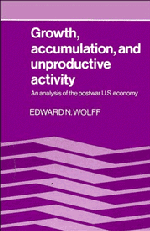Book contents
- Frontmatter
- Contents
- Preface
- 1 Introduction
- 2 Unproductive activity in a capitalist society
- 3 A Marxian accounting framework
- 4 A growth model of accumulation and unproductive labor
- 5 Rise of unproductive activity in postwar economy
- 6 Absorption of labor and capital and rate of surplus value
- 7 Absorption of new resources and growth in real income
- 8 Conclusions and speculations
- Appendix: Data sources and methods
- References
- Index
7 - Absorption of new resources and growth in real income
Published online by Cambridge University Press: 24 March 2010
- Frontmatter
- Contents
- Preface
- 1 Introduction
- 2 Unproductive activity in a capitalist society
- 3 A Marxian accounting framework
- 4 A growth model of accumulation and unproductive labor
- 5 Rise of unproductive activity in postwar economy
- 6 Absorption of labor and capital and rate of surplus value
- 7 Absorption of new resources and growth in real income
- 8 Conclusions and speculations
- Appendix: Data sources and methods
- References
- Index
Summary
The cost of winning a seat in the House of Representatives rose again in 1984, but only by about half as much as it has in recent elections, according to an analysis of compaign spending reports.
This year's winners will have spent an average of about $325,000 when all reports are filed, up about 23 percent from the average spending in 1982, according to an analysis done for The New York Times by Sunshine News Services, a company that studies compaign spending. The 1982 averages were 47 percent above those of 1980, which were 40 percent above 1978's.
Political analysis offered several explanations for the slowdown of campaign inflation, an effect that was not found in this year's very expensive Senate races. They cited the small number of serious challengers to incumbents, the decline in the overall rate of inflation and the fact that there had been fewer technological advances in campaigning, which drive up costs, than there had been in recent elections. …
One reason for the slowdown of inflation in House election spending, suggested Eddie Mahe, a leading Republican political consultant, “is the decline in the overall rate of inflation,” a view that was shared by Peter Fenn, a Democratic consultant who works with House candidates.
Between 1980 and 1982, when the average amount spent on winning a House seat went from $179,140 to $263,290, a 47 percent increase, the estimated inflation for the entire economy was 16 percent.
- Type
- Chapter
- Information
- Growth, Accumulation, and Unproductive ActivityAn Analysis of the Postwar US Economy, pp. 141 - 163Publisher: Cambridge University PressPrint publication year: 1986



